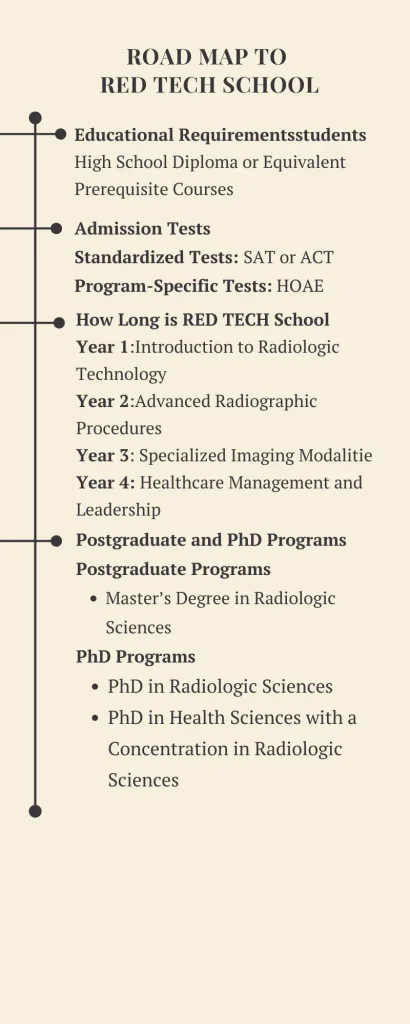How Long is Rad Tech School
How long is rad tech school typically varies, but most programs take around two years to complete. These programs often result in an associate degree, preparing students for entry-level positions in radiologic technology. Some may opt for a four-year bachelor’s degree, which can offer more advanced opportunities.
What is Rad Tech School?
Rad tech school trains individuals to become radiologic technologists, professionals skilled in performing diagnostic imaging procedures, such as X-rays and MRIs. These programs combine classroom instruction with hands-on clinical experience, covering anatomy, patient care, radiation safety, and imaging techniques. Graduates are prepared to enter the workforce and assist healthcare teams in diagnosing and treating medical conditions.

Rad tech schools offer a variety of program lengths and degrees, from two-year associate degrees to four-year bachelor’s degrees. They emphasize both theoretical knowledge and practical skills, ensuring students are well-equipped to handle the technical and patient care aspects of the job. Successful completion often leads to certification and licensure, essential for professional practice.
How Long is Rad Tech School
Year 1: Introduction to Radiologic Technology
Introduction to Radiologic Technology: Students are introduced to the basics of radiologic technology, including medical terminology, patient care, and ethics.
Basic Anatomy and Physiology: Courses cover human anatomy and physiology, focusing on systems relevant to imaging.
Radiographic Procedures I: Introduction to basic imaging techniques and procedures, including positioning and equipment handling.
Radiation Protection: Basics of radiation safety and protection principles.
Year 2: Advanced Radiographic Procedures
Advanced Radiographic Procedures: Building on first-year knowledge, students learn more complex imaging techniques and procedures.
Imaging Equipment and Quality Control: In-depth study of imaging equipment operation and maintenance, along with quality control measures.
Clinical Practicum I: Hands-on clinical experience in a healthcare setting, applying classroom knowledge to real-world scenarios.
Pathology: Study of diseases and how they appear on imaging studies.
Year 3 (for bachelor’s programs):
Specialized Imaging Modalities: Courses on advanced imaging techniques like CT, MRI, and mammography.
Radiation Biology: Study of the effects of radiation on biological tissues and radiation safety protocols.
Clinical Practicum II: More extensive clinical experience, allowing students to refine their skills and gain confidence.
Research Methods in Radiologic Sciences: Introduction to research methodologies and evidence-based practice in radiology.
Year 4 (for bachelor’s programs):
Healthcare Management and Leadership: Courses on management, leadership, and healthcare administration, preparing students for potential supervisory roles.
Advanced Patient Care: Advanced techniques in patient care and communication.
Clinical Practicum III: Final clinical rotation, providing comprehensive hands-on experience and preparation for professional practice.
Capstone Project: A final project or thesis that demonstrates the student’s knowledge and skills in radiologic technology.

Completion of these programs typically prepares students for certification exams and state licensure, which are necessary for professional practice as a radiologic technologist.
How to Enter Rad Tech School
Educational Requirements for Rad Tech School
High School Diploma or GED: Completion of high school or equivalent is mandatory.
Prerequisite Courses: Courses in math, biology, anatomy, and physics are often required.
Minimum GPA: Many programs require a minimum GPA, typically around 2.5-3.0.
Entry Tests for Rad Tech School
Standardized Tests: Some schools may require SAT or ACT scores.
Program-Specific Tests: Certain programs might have specific entrance exams or assessments, such as the Health Occupations Aptitude Examination (HOAE).
Application Process for Rad Tech School
Application Form: Complete the application form available on the school’s website.
Transcripts: Submit official high school or college transcripts.
Letters of Recommendation: Provide letters from teachers, employers, or healthcare professionals.
Personal Statement: Write a personal essay explaining your interest in radiologic technology.
Interview: Some programs may require an interview as part of the selection process.
Application Fee: Pay any required application fee.
Financial Aid for Rad Tech School
Federal Student Aid: Complete the Free Application for Federal Student Aid (FAFSA) to determine eligibility for federal loans, grants, and work-study programs.
Scholarships: Look for scholarships specific to healthcare and radiologic technology students.
State Aid: Investigate state-specific grants and scholarships.
School-Based Financial Aid: Many schools offer their own grants, scholarships, and work-study opportunities.
Private Loans: Consider private loans if additional funding is needed.
Military Benefits: Veterans and active-duty military personnel may qualify for educational benefits through programs like the GI Bill.
Post Graduate and PhD Programs for Rad Tech School
Post Graduate Program
Master’s Degree in Radiologic Sciences
Program Focus: Advanced clinical skills, leadership, and management in radiologic sciences.
Typical Duration: 1-2 years.
Core Courses:
Advanced Imaging Techniques
Healthcare Administration
Research Methods in Radiologic Sciences
Radiation Therapy
Clinical Leadership
Clinical Practicum: Enhanced hands-on experience in advanced imaging modalities.
Capstone Project: A research project or thesis in a specialized area of radiologic sciences.
Certificate Programs
Specializations: Computed Tomography (CT), Magnetic Resonance Imaging (MRI), Mammography, Interventional Radiology.
Typical Duration: 6 months to 1 year.
Core Courses:
Specialized Imaging Procedures
Patient Care in Advanced Imaging
Imaging Equipment and Safety
Clinical Practicum: Focused clinical experience in the chosen specialization.
Certification: Prepares for additional certification exams in the specific modality.
PhD Programs for Rad Tech School
PhD in Radiologic Sciences
Program Focus: Research, academia, and advanced practice in radiologic sciences.
Typical Duration: 3-5 years.
Core Courses:
Advanced Research Methods
Biostatistics
Advanced Imaging Techniques
Radiologic Science Theory
Healthcare Policy and Ethics
Research: Extensive original research culminating in a dissertation.
Teaching: Opportunities to teach undergraduate courses and mentor students.
Dissertation: A significant original contribution to the field of radiologic sciences.
PhD in Health Sciences with a Concentration in Radiologic Sciences
Program Focus: Interdisciplinary research and leadership in health sciences with a focus on radiologic technology.
Typical Duration: 3-5 years.
Core Courses:
Interdisciplinary Health Research
Healthcare Leadership
Advanced Imaging and Radiation Therapy
Healthcare Policy and Management
Research: Original research in radiologic sciences or related health disciplines.
Dissertation: Original research project contributing to the broader field of health sciences.
Top 10 Rad Tech Schools

1.University of California, San Francisco (UCSF)
Programs Offered: Bachelor’s, Master’s, and PhD in Radiologic Sciences.
Notable Features: State-of-the-art facilities, leading research programs, and clinical partnerships with top medical centers.
2.Johns Hopkins University
Programs Offered: Bachelor’s and Master’s in Medical Imaging, Certificate Programs.
Notable Features: Renowned for cutting-edge research, extensive clinical training, and highly experienced faculty.
3.Mayo Clinic College of Medicine and Science
Programs Offered: Associate, Bachelor’s, and Certificate Programs in Radiologic Technology.
Notable Features: Hands-on training in one of the world’s leading healthcare systems, strong emphasis on patient care and clinical excellence.
4.Massachusetts General Hospital Institute of Health Professions
Programs Offered: Bachelor’s and Master’s in Radiologic Sciences.
Notable Features: Affiliated with one of the best hospitals in the U.S., providing extensive clinical experience and research opportunities.
5.University of Iowa
Programs Offered: Bachelor’s and Master’s in Radiologic Technology.
Notable Features: Strong emphasis on research and clinical practice, with numerous clinical placement opportunities.
6.University of Southern California (USC)
Programs Offered: Bachelor’s in Radiologic Sciences.
Notable Features: Comprehensive curriculum, access to top medical facilities, and strong alumni network.
7.Ohio State University
Programs Offered: Bachelor’s in Radiologic Sciences.
Notable Features: Excellent faculty, modern facilities, and diverse clinical rotation sites.
8.Emory University
Programs Offered: Bachelor’s and Master’s in Medical Imaging.
Notable Features: Emphasis on advanced imaging techniques, research, and strong clinical training programs.
9.University of Pittsburgh
Programs Offered: Bachelor’s in Radiologic Sciences.
Notable Features: Strong focus on both academic and clinical excellence, with numerous clinical partnerships.
10.Thomas Jefferson University
Programs Offered: Bachelor’s and Master’s in Radiologic Sciences.
Notable Features: Leading programs in imaging sciences, extensive clinical training, and strong emphasis on research and innovation.
These schools are renowned for their high-quality education, extensive clinical training, and strong emphasis on research, preparing students for successful careers in radiologic technology.
Factors Affecting the Length of Rad Tech School
Program Type
Certificate Programs:
Duration: Typically 1 year or less.
Focus: Provide specialized training in specific imaging modalities (e.g., CT, MRI).
Target Audience: Individuals who already have a background in healthcare or radiologic technology.
Associate Degree Programs:
Duration: Approximately 2 years.
Focus: Comprehensive education covering basic to intermediate radiologic technology skills.
Target Audience: High school graduates or individuals with limited healthcare experience.
Bachelor’s Degree Programs:
Duration: Approximately 4 years.
Focus: In-depth education including advanced imaging techniques, research, and management.
Target Audience: High school graduates seeking a thorough education in radiologic technology.
Clinical Training Requirements
Clinical Hours: Programs require a certain number of clinical hours to ensure hands-on experience.
Associate Programs: Often require around 1,000-1,500 clinical hours.
Bachelor’s Programs: May require more extensive clinical training, sometimes exceeding 2,000 hours.
Clinical Sites: Availability and variety of clinical sites can impact the duration, as some programs may offer more extensive or diverse clinical experiences.
Part-time vs. Full-time Enrollment
Full-time Enrollment:
Duration: Typically completes the program in the standard timeframe (e.g., 2 years for an associate degree).
Advantages: Faster entry into the workforce.
Part-time Enrollment:
Duration: Extends the program length, potentially doubling the time required.
Advantages: Allows students to work or manage other responsibilities while studying.
Prerequisite Courses
Prior Education:
Students with completed prerequisite courses in areas like anatomy, physiology, and medical terminology may reduce their overall program length.
Example: A student with prior college coursework might finish a program faster than one starting from scratch.
State and Program-Specific Requirements
State Licensure Requirements: Some states may have additional requirements, such as specific clinical hours or additional coursework, potentially extending the program length.
Accreditation Standards: Programs accredited by organizations like the Joint Review Committee on Education in Radiologic Technology (JRCERT) may have stringent requirements, influencing program length.
Advanced Standing or Accelerated Programs
Accelerated Programs:
Duration: Designed to be completed in a shorter timeframe (e.g., 18 months instead of 24 months for an associate degree).
Requirements: Often require more intensive study and faster-paced coursework.
Advanced Standing:
Credits for Experience: Students with prior experience or education in healthcare may receive credit, reducing the time needed to complete the program.
These factors collectively influence the length of rad tech programs, affecting how quickly a student can progress through their education and enter the workforce.
Final Verdict
The length of rad tech school varies based on program type, clinical training requirements, enrollment status, and prerequisite coursework. Understanding these factors helps prospective students choose the best path to achieve their career goals in radiologic technology.
FAQs
1.What is the average duration of rad tech school?
Rad tech programs typically range from 1 to 4 years, depending on whether you pursue a certificate, associate degree, or bachelor’s degree.
2.Do I need any prerequisites for rad tech school?
Yes, many programs require prerequisite courses in subjects like anatomy, physiology, and medical terminology.
3.Are there part-time options available for rad tech programs?
Yes, many schools offer part-time enrollment options, which extend the program length but provide flexibility for students.
4.What kind of clinical training is required in rad tech programs?
Clinical training varies but generally includes 1,000 to 2,000 hours of hands-on experience in healthcare settings, depending on the program.
5.Can I receive financial aid for rad tech school?
Yes, financial aid options include federal and state aid, scholarships, grants, and loans. Completing the FAFSA is essential to determine eligibility.
